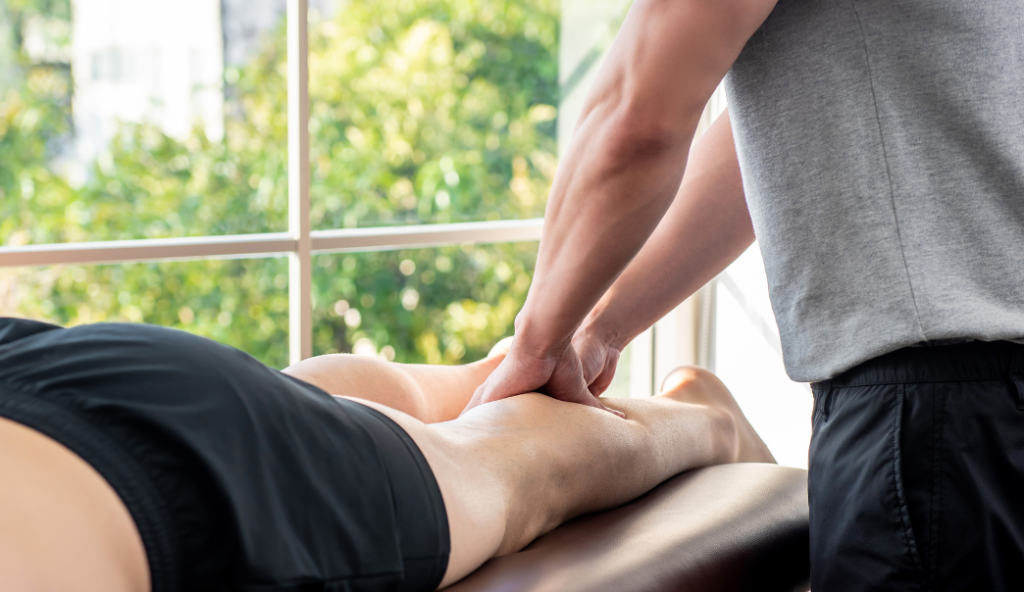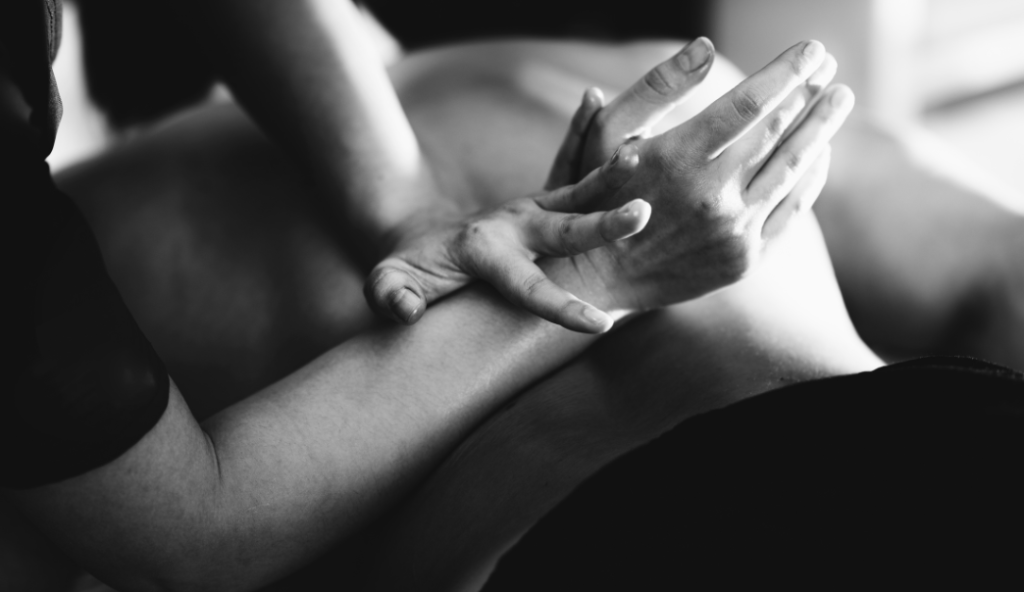Sports massage has long been recognized as crucial in an athlete’s training and recovery program. As athletes push their bodies to the limit, sports massage provides numerous benefits. In this article, we will explore the critical advantages of sports massage and how it can contribute to their overall performance and well-being.
Essential Techniques in Sports Massage for Peak Performance
Athletes often turn to sports massage to enhance their performance. One of the critical techniques used in sports massage is deep tissue massage. Targeting the deeper layers of muscles and connective tissues helps release muscle tension, improve flexibility, and increase blood flow to the muscles.
Deep Tissue Massage
Deep tissue massage involves applying firm pressure and slow strokes to reach the underlying muscles. This technique is particularly beneficial for athletes who engage in intense physical activities, as it helps break down adhesions and scar tissues that can develop from repetitive motions or injuries. By releasing these adhesions, deep-tissue massage promotes a better range of motion and reduces the risk of future injuries.
Effleurage and Petrissage
In addition to deep tissue massage, sports massage therapists utilize techniques such as effleurage and petrissage. Effleurage involves long, sweeping strokes that help warm up the muscles and prepare them for more profound work. This technique stimulates blood circulation, improving the delivery of oxygen and nutrients to the muscles.
Petrissage, on the other hand, involves kneading, rolling, and squeezing the muscles. This technique helps break up muscle knots and adhesions while promoting relaxation and reducing muscle soreness. By incorporating effleurage and petrissage into a sports massage session, therapists can address the superficial and deeper layers of muscles, ensuring a comprehensive treatment.
When combined with the expertise of a skilled sports massage therapist, these techniques can significantly improve an athlete’s performance. The therapist’s knowledge of anatomy and physiology allows them to identify specific areas of tension or imbalance in an athlete’s body. The therapist can help restore balance, enhance muscle function, and improve overall athletic performance by targeting these areas during the massage.
Massages for Faster Muscle Recovery
Furthermore, sports massage benefits athletes during training and competition and is crucial to their recovery. After an intense workout or competition, athletes may experience muscle soreness, fatigue, and even minor injuries. Sports massage can help speed recovery by reducing inflammation, promoting muscle relaxation, and increasing blood flow to the affected areas.
Regular sports massage sessions can also contribute to injury prevention. By addressing muscle imbalances, tightness, and areas of weakness, sports massage can help athletes identify and correct potential issues before they develop into more severe injuries. This proactive approach to injury prevention can ultimately prolong an athlete’s career and keep them performing at their peak.
Sports Massage in Injury Prevention and Recovery
While sports massage is well-known for its benefits in enhancing performance, it also plays a crucial role in preventing injuries and aiding in recovery. By incorporating sports massage into their regular training routine, athletes can reduce the risk of developing sports-related injuries such as sprains, strains, and muscle imbalances. Sports massage can also speed up the recovery process by promoting muscle healing, reducing inflammation, and eliminating metabolic waste products from the body.
In addition to these primary benefits, sports massage offers a range of secondary advantages that contribute to an athlete’s overall well-being. One such advantage is the improvement in circulation that occurs during a sports massage session. As the therapist applies various techniques, blood flow to the muscles increases, delivering oxygen and nutrients while removing waste products. This enhanced circulation not only aids in recovery but also helps prevent muscle fatigue and cramping during intense physical activity.
Another lesser-known benefit of sports massage is its impact on the nervous system. The therapist can use specific massage techniques to stimulate the parasympathetic nervous system, promoting relaxation and reducing stress levels. This can be particularly beneficial for athletes who often experience high levels of physical and mental stress. By incorporating sports massage into their routine, athletes can better balance their sympathetic and parasympathetic nervous systems, leading to improved overall performance and well-being.

The Role of Stretching in Sports Massage
In addition to massage techniques, stretching is an integral part of sports massage for both injury prevention and recovery. Stretching exercises and targeted massage techniques help increase joint range of motion, improve muscle elasticity, and prevent muscle imbalances. Whether it’s passive stretching, active stretching, or proprioceptive neuromuscular facilitation (PNF) stretching, incorporating stretching into sports massage can be highly effective in maintaining and restoring an athlete’s physical well-being.
Stretching not only improves flexibility but also enhances muscle coordination and balance. By incorporating stretching into a sports massage session, the therapist can address any imbalances or tightness in the muscles, helping the athlete achieve optimal performance. Additionally, stretching can help prevent overuse injuries by ensuring that muscles and tendons are properly conditioned and prepared for the demands of intense physical activity.
Furthermore, stretching during a sports massage session can provide a valuable opportunity for the therapist to assess an athlete’s flexibility and identify any areas of concern. This allows for a more targeted and personalized approach to the massage, ensuring that the athlete receives the most effective treatment for their needs.
The Importance of Proper Body Mechanics
Regarding sports massage, the therapist’s body mechanics are crucial in ensuring optimal results. Proper body mechanics refer to the therapist’s posture, positioning, and massage techniques. By maintaining good body mechanics, therapists can apply the right amount of pressure, minimize strain on their bodies, and effectively target the areas that require attention. This not only enhances the effectiveness of the massage but also reduces the risk of injury to both the therapist and the athlete.
Additionally, proper body mechanics can contribute to the overall comfort and relaxation of the athlete during the massage. By adopting a stable and balanced posture, the therapist can create a sense of trust and security, allowing the athlete to relax and benefit from the treatment entirely. This relaxed state enhances the massage’s physical effects and promotes mental and emotional well-being.
Furthermore, maintaining proper body mechanics is essential for the longevity of a sports massage therapist’s career. By using efficient and ergonomic techniques, therapists can minimize the risk of developing musculoskeletal injuries or chronic pain conditions. This ensures that they can continue providing high-quality care to athletes for years.
Tailoring Sports Massage to Individual Athlete Needs
Every athlete is unique and has specific needs regarding their training and recovery. Sports massage therapists excel in tailoring their techniques and approaches to meet these individual needs. The massage therapist can develop a personalized treatment plan by conducting thorough assessments and considering an athlete’s goals, preferences, and existing conditions. This individualized approach ensures that athletes receive the maximum benefits from sports massage, allowing them to perform at their best.
Different People Need Different Treatment
When it comes to sports massage, one size does not fit all. Athletes come from various backgrounds and have different training regimens, so their bodies require specific attention. A skilled sports massage therapist understands this and takes the time to assess each athlete’s unique needs. They consider factors such as the athlete’s sport, training intensity, and any areas of concern or injury.
During the assessment phase, the therapist may ask the athlete about their training routine, including the frequency and duration of their workouts. This information helps the therapist understand the demands on the athlete’s body and identify areas that may require extra attention. For example, a long-distance runner may have tight hip flexors and calves due to the repetitive nature of their sport, while a weightlifter may have tension in their shoulders and lower back from heavy lifting.
Developing a Personalized Plan
Once the assessment is complete, the sports massage therapist can develop a personalized treatment plan addressing the athlete’s needs. This plan may include a combination of techniques such as deep tissue massage, myofascial release, stretching, and trigger point therapy. The therapist will also consider the athlete’s preferences, as some individuals may prefer a more intense massage while others may prefer a gentler approach.
During the sports massage session, the therapist will focus on the areas identified during the assessment. They will use their knowledge of anatomy and physiology to apply the appropriate techniques and pressure to release tension, improve circulation, and promote relaxation. The therapist may also guide self-care techniques and stretches that the athlete can incorporate into their daily routine to enhance the benefits of the massage.
Creating a Supportive and Motivated Environment
In addition to addressing the athlete’s physical needs, sports massage therapists also understand the importance of creating a supportive and comfortable environment. They strive to establish a rapport with the athlete, ensuring open communication and trust. This allows the athlete to feel at ease during the session, enhancing the overall experience and promoting well-being.
By tailoring sports massage to individual athlete needs, therapists can help athletes optimize their performance, prevent injuries, and enhance their overall well-being. Whether a professional athlete preparing for a competition or a recreational athlete recovering from a challenging workout, a personalized sports massage can significantly impact their training and recovery journey.

Case Studies: Sports Massage Success Stories
Countless athletes have experienced the transformative effects of sports massage. Let’s delve into a few inspiring case studies that highlight the power of sports massage in enhancing performance, preventing injuries, and aiding in recovery.
Integrating Sports Massage into Training Regimens
For athletes, incorporating sports massage into their training regimens is a game-changer. Regularly integrating sports massage helps athletes maintain balance in their musculoskeletal system, prevent overuse injuries, and optimize their overall physical condition. By working closely with their massage therapists and making sports massage an integral part of their fitness routine, athletes can reach new heights of performance and achieve their goals.
Navigating Common Misconceptions About Sports Massage
Despite its proven benefits, sports massage still faces misconceptions that deserve attention. Let’s address a few common myths and set the record straight:
- Myth 1: Sports massage is only for professional athletes.
- Myth 2: Sports massage is painful and uncomfortable.
- Myth 3: Sports massage is a luxury, not a necessity.
By debunking these misconceptions, we hope to encourage more athletes of all levels to explore the extraordinary advantages of sports massage.
Expert Insights: What Athletes Should Know
Who better to shed light on the benefits of sports massage than experts in the field? We contacted leading sports massage therapists and asked them to share their insights and advice for athletes. Let’s discover what they have to say about unlocking the full potential of sports massage for athletic excellence.
The Future of Sports Massage in Athletic Care
As sports science and therapeutic techniques continue to evolve, the future of sports massage appears promising. With technological advancements, research, and training methodologies, we can expect sports massage to become an even more integral part of athletic care. This includes the development of specialized massage techniques and tools that cater to various sports-specific needs. By embracing these advancements, athletes can unlock new levels of performance and well-being.
Embracing Sports Massage for Athletic Excellence
Sports massage offers many benefits for athletes, from enhancing performance to preventing injuries and aiding in recovery. By utilizing key techniques, customizing treatments to individual needs, and integrating sports massage into their training regimens, athletes can unlock their full potential and achieve athletic excellence. Let’s embrace the power of sports massage and optimize our physical well-being for a successful and fulfilling athletic journey.



